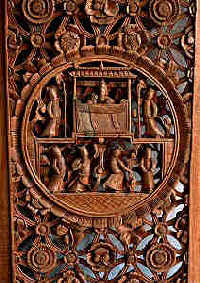 Latticework is often enhanced by various motifs such as arabesques (intricate floral designs), figures, and episodes from local operas and folk stories. Geometric and cross patterns are also favored because they are simple yet graceful. There are also motifs based on the symbols of the five elements (air, earth, fire, water, and wood) and the eight trigrams (sky, earth, thunder, wind, water or moon, fire or sun, mountain, and water). The carved boards are mainly those from doors, windows, tables, beds, chairs, and screens.
Latticework is often enhanced by various motifs such as arabesques (intricate floral designs), figures, and episodes from local operas and folk stories. Geometric and cross patterns are also favored because they are simple yet graceful. There are also motifs based on the symbols of the five elements (air, earth, fire, water, and wood) and the eight trigrams (sky, earth, thunder, wind, water or moon, fire or sun, mountain, and water). The carved boards are mainly those from doors, windows, tables, beds, chairs, and screens.
Wood employed to make them are mostly nanmu, zhangmu (camphor wood), baimu (cypress wood), red sandalwood, zitan (padauk), ebony and so on. Of these, nanmu and red sandalwood are the most highly valued materials, as they are dense, hard, and resistant to decay. The methods of carving include relief carving, line engraving, negative engraving, openwork carving, and free-style carving, applied accordingly to wood of different textures.
 Flourishing age of decorative arts
Flourishing age of decorative arts
China's traditional architectural ornamentation, a centuries-old art in which carved wood doors and windows played an important role, prevailed especially during the Ming and Qing periods.
By the end of the 16th century, architectural ornament, which became very popular during the Song Dynasty (960-1279) over 1,000 years ago, had become a sumptuous part of a building, with great displays of marquetry (inlaid works) and carving, decorated with beautiful latticework motifs derived from traditional designs that reflected Chinese culture.
The Ming Dynasty was an age of expansion and prosperity when decorative arts flourished, while its wood doors and windows, simple but elegant, were characterized by soft curves, flowing lines and appealing proportions. This distinct artistic style could also be seen in all varieties of Ming furniture. Great emphasis was placed on the use of the wood's natural beauty together with the adoption of latticework and openwork carving.